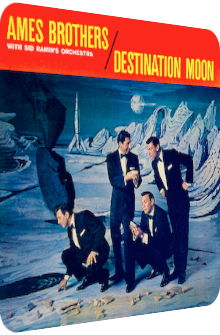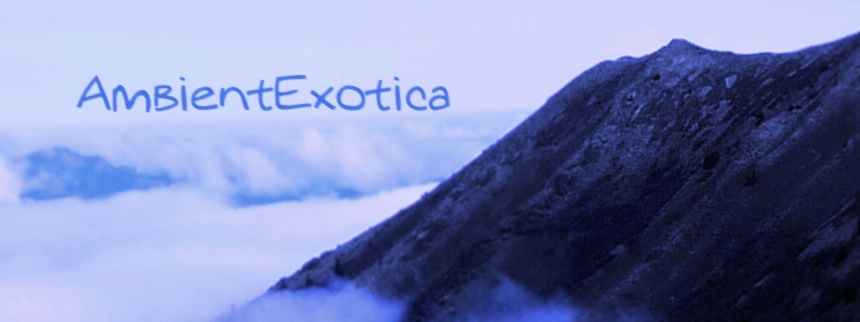
Ames Brothers
Destination Moon
1958
Even though this website is called AmbientExotica, I cannot deny the close entanglement of the Space-Age genre with both the Lounge lands and Exotica anthems. And luckily enough, there are albums that target all three styles to great success, if not always in equal parts. Destination Moon by the vocal quartet called the Ames Brothers, released in 1958 on RCA Victor, is an especially vivid artifact of the excitingly effervescent North American Space-Age era. Brothers Joe, Gene, Vic and Ed sing 12 well-known Jazz and big band standards that all have a close relation to the lunar or stellar concept as poignantly and actually tastefully depicted on the front artwork.
While I rarely review vocal Exotica-related albums, I am more than pleased in this case, as the brothers do not rely on their vocal skills alone, but luckily bring conductor Sid Ramin on board whose orchestra just underlines the quartet at worst and delivers stunningly energetic or enchanting bridges and instrumental segues at best. Horns, violins and timpani are the gold standard of late 50's albums, but I would be damned if there weren't genuinely positive surprises in store that are closely tied to Latin arrangements and tropical ditties. If the mood isn't romantic, it is regularly uplifting: the joy, the positive vibe of that era is perfectly encapsulated, and encountering tunes like this lets contemporary listeners enter a mild-mannered, brightly blithesome world where technocratic blueprints did not yet evoke the epidemically spread fear of technological prowess and megalomania.
Destination Moon is the eponymous opener of this album, and I am still awestruck about the skillful opening section that is unexpectedly vivid for its time. Don’t expect a synthesizer fest à la Korla Pandit, that was simply not the accepted standard in 1958, but the eerie space-injecting violin infusion works well in tandem with the frantic countdown announcer, the crackling static noise and the upwards spiraling brass fanfares. For a seemingly cruddy vocal album, this is the cinematic launch if there ever was one. But Roy Alfred’s and Marvin Fisher’s famous ditty remains in Space-Age territories with the Ames Brothers singing cheerfully along to the gleaming horn flourishes, the purposefully reduced jazzy double bass backings and the rose-tinted pizzicato droplets. The glee of that era is perfectly delivered, the balance between a vocal-focused setting and an orchestral accompaniment well met.
The brothers’ take on Al Dubin’s and Jimmy McHugh’s Clear Out Of This World boosts the Jazz factor but alters it with doleful, if also galactic flutes. It is only in the second half that the brazen brass attacks grow louder and, mind you, show one of the concept-related flaws, as the overly silky vocals don’t fit with neither the ice-cold first phase nor the sizzling-hot hornscape in the latter half. The discrepancy is remarkable, and to my mind unsolvable. A cooler approach as in the opener would have been better suited, but as usual, my mild criticism is brought late to the table. Decades too late.
While Eddie DeLange’s and Will Hudson’s Moonglow is a tremendously syrupy downtempo take where the Ames guys are at least perfectly backed by languorous strings and moony glockenspiel glints, Brooks Bowman’s classic East Of The Sun (And West Of The Moon) provides a similarly harmonious listening experience, as the brass sections are as mellifluous as the smooth timbre of the guys. Count Every Star, originally written by Bruno Coquatrix and Sammy Gallop, is a real treat however, as Sid Ramin’s orchestra plays the wafting strings and the glistening mallet instruments in a phantasmagoric manner, adding the important glacial counterpart to the saccharine warmth in the Ames Brothers’ voices. The cascading flute tones at the very end are among the dreamiest you will encounter on this album. Side A closes with Redd Evans’ No Moon At All, and it is a fantastic over-the-top big band joyride full of sparkling brass stabs, smashing cymbals and droning timpani. The orchestra is given room to breathe, and even the brothers return to their witty staccato style of singing, harking back to the opener. It’s a great tune and one of my favorites.
The second song provided by Jimmy McHugh which he has co-written with Ted Koehler, called I’m Shooting High, opens side B and expands the stylistic pool for the first time, as coupled pizzicato globs of glockenspiels and violins lead to dynamic but eupeptic maelstroms of screeching strings and the already well-known brass-focused settings. The ever-changing instrumental interplay, however, is gorgeous, glueing diverse vignettes to each other, thus delivering a highly diverse setup which outshines the already salient performance of the Ames Brothers who seem to have the most fun in the world. The short military march segues are absolutely mind-blowing in the given context, even more so since I am quite wary (!) of military influences in Space-Age, Lounge and Exotica music. But here they work entirely well. The best song of the album!
Roy Alfred’s Music From Out Of Space can only lose after such a vivaciously fulminant outing, but the string-fueled dreamscape actually works excellently, even more so since the orchestra players offer many solos, as does one of the Ames Brothers who leaves the polyphonous snugness for a short while. The interpretation of Ned Washington’s and Victor Young’s Stella By Starlight remains in romantic galaxies, and while I prefer the take of The Three Suns, Sid Ramin’s orchestra surprises with quirky space flutes and a scintillating version of the glockenspiels. The strings are lavish, The Ames Brothers unfortunately a tad too sugar-sweet, but the quiescence and peacefulness of the atmosphere do indeed evoke a nocturnal feeling. Considering the other romantic takes of the album, I rate Stella By Starlight as their best try. Not that the Brothers would mind anymore if my opinion differed.
After the focus on romance, love and devotion, it’s time for an ebullient, exhilarative big band anthem, and it approaches the scene in the form of Harold Arlen’s and Billy Rose’s It’s Only A Paper Moon. A typical wave-like double bass-backed base frame meanders in close proximity to surprisingly acidic Dixieland-influenced brass attacks and more speaking or even shouting than singing Ames Brothers. For these concept-widening particles, I am raising my hat in front of this otherwise strangely laced up take. The Starlit Hour by Peter DeRose and Mitchell Parish is the last romantic ballad and surprises with allotted piano notes, mighty-mellow string gusts and their mystically vesicle-friendly cascading brethren.
The brothers are keen on another solo performance in the vein of Hawaiian superstar Alfred Apaka, and yet again allow the orchestra to play unperturbed by their vocals for several seconds. The final Beyond The Blue Horizon by William Frank Harling, Leo Robin and Richard A. Whiting closes the album. And huzzah, it is as a tremendously worthwhile rendition. Paradisiac (!) flutes, bongo (!) beats, fast-paced bass backings, galactosamine strings, clashing cymbals, staccato horn blows as well as uplifting Ames Brothers altogether create a stunning ephemeral piece that only leaves out the glockenspiels, but adds such a surprising and welcome wealth of exotic elements that I am once again swallowing any ferocious remark I could have unleashed, pondering instead why this huge amount of instruments has not been featured heretofore. A great outro to a good vocal-driven Space-Age suite.
Exotica fans will miss The Moon Of Manakoora, but apart from this glaring omission, there is plenty of moon-related material featured on the album. As is the case with most vocal releases, I prefer the uplifting, jocular material a lot more than the over-exposed piles of sugar that coat the softly melting voices of the Ames Brothers' romantic interpretations. And yet, Stella By Starlight is as good a song that targets fans of the latter style, while both the intro Destination Moon and the outro Beyond The Blue Horizon are tremendously catchy tunes that live up to the promised concept thanks to Sid Ramin's orchestra. The countdown motif in tandem with the eerie strings already provides a pitch-perfect launch of the LP, but it is the remarkable exotic feeling of the percussion-heavy outro that makes the Exotica afficionado's heart jump with joy… and leave him or her largely annoyed due to the missed opportunity.
Unfortunately, a real Exotica outing by the Ames Brothers was never meant to be, as Destination Moon is the penultimate album by the band, with only one true release and a Best Of following afterwards. Beyond The Blue Horizon shows how vivid a greatly orchestrated Exotica album would have sounded. But even as a whole, the album offers much for those who can take the romance. The quartet delivers one of the greatest performances of the Space-Age era, with each song fully transporting – better still: transfiguring – the carefree spirits of the time. As I've stated in the opening paragraph, Destination Moon is no Exotica album, being one of the reasons why I never paid much attention despite it being a heirloom, but as it is always the case with each reviewed release of this section, it is close enough to ponder about its qualities and missed chances.
Exotica Review 134: Ames Brothers – Destination Moon (1958). Originally published on Oct. 20, 2012 at AmbientExotica.com.
